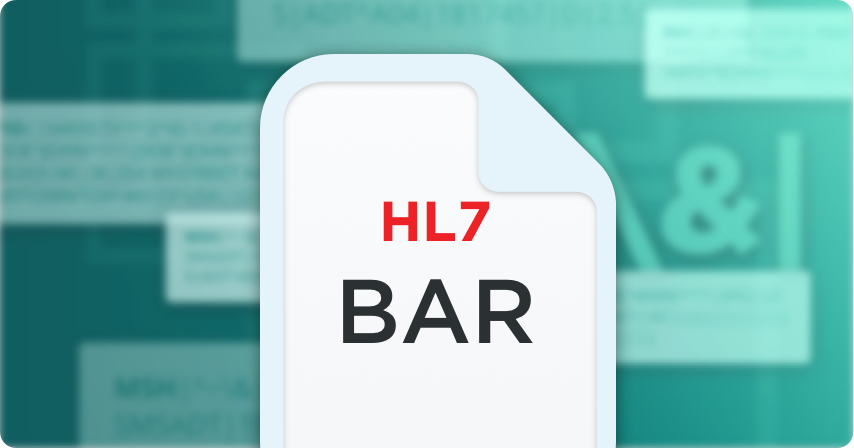
HL7 BAR
Billing Account Record
An HL7 Billing Account Record (BAR) message is used to make changes to a patient’s billing account information, or to add new patient accounts.
BAR (Billing Account Record)
This message type is typically used when data is sent from an ADT or registration system to a patient accounting system in order to create or add to a patient’s account receivable/billing record. Many segments within this data type are optional. The BAR message has 5 different message types that are used to transmit this data:
- BAR^P01: Add patient accounts.
- BAR^P02: Deleted patient accounts.
- BAR^P05: Update patient account.
- BAR^P06: End account.
- BAR^P10: Transmit Ambulatory Payment Classification (APC) grouping.

Sample BAR Message
Below is an example of an HL7 version 2.3 BAR^P01 message, used to create a new patient account:
EVN||20200420134725||
PID|||3000222452||DOE^JOHN^E||19931114|M||||||||||1546740|666381774|
PV1||I|BRACKENRIDGE|||||023434|||||||||023434|||||||||||||||||||||||||||20031121||
GT1|0||DOE^JOHN^E||756 E FANNIN ST^^LAGRANGE^TX^789450000|9799660489|||||M|||||CARE INN|457 NMAIN^^LAGRANGE^TX^78945|
IN1|1|T71|||MEDICAID
| Segment | Description |
|---|---|
| MSH | Message Header. The header contains information about the sending system and location, the receiving system and location, the date and time of when the message was created, the type of trigger event being communicated, and the HL7 message version being used. This segment is required. |
| EVN | Event Type. Communicates the event that occurred in order for the message to be generated. This is a crucial part of the data flow, as it indicates where and when a message is sent based on the type of event. This segment is required. |
| PID | Patient Identification. Important patient identification information, including patient demographics. This segment is required. |
| PV1 | Patient Visit. Contains information about patient visit details such as servicing facility, attending doctor, and visit ID. This segment is required. |
| [{GT1}] | Guarantor Information. This segment contains information about the person or organization financially responsible for the patient’s account. This segment is optional and can be repeated. |
| IN1 | Policy Coverage. Information about the patient’s insurance policy is listed here and is used to create patient and insurance bills. This segment is required. |
| [ ] = optional, { } = repeating | |
For more information on implementing various HL7 message types, please refer to the HL7 Messaging Standard Implementation Guides corresponding to your required version.
Working With BAR Messages
Are you working with HL7 BAR messages? In order to successfully process these messages, it's important to understand the specific format that the sending and receiving facilities are expecting the BAR messages to adhere to. Discrepancies can occur due to the version of HL7, system input error, or even simply human error when the messages were created.
How does Iguana ensure that BAR messages are properly formatted to ensure system compatibility?
Iguana is a data integration platform that allows you to easily customize the format, structure, and field values of your HL7 messages so that they are normalized, ensuring compatibility with any system you might need to interact with.
Other HL7 Message Types
- HL7 ADT (Admit, Discharge and Transfer)
- HL7 ORM (Order Entry)
- HL7 ORU (Observation Result)
- HL7 MDM (Medical Document Management)
- HL7 DFT (Detailed Financial Transactions)
- HL7 BAR (Billing Account Record)
- HL7 SIU (Scheduling Information Unsolicited)
- HL7 RDS (Pharmacy/treatment Dispense)
- HL7 RDE (Pharmacy/Treatment Encoded Order)
- HL7 ACK (Acknowledgement Message)